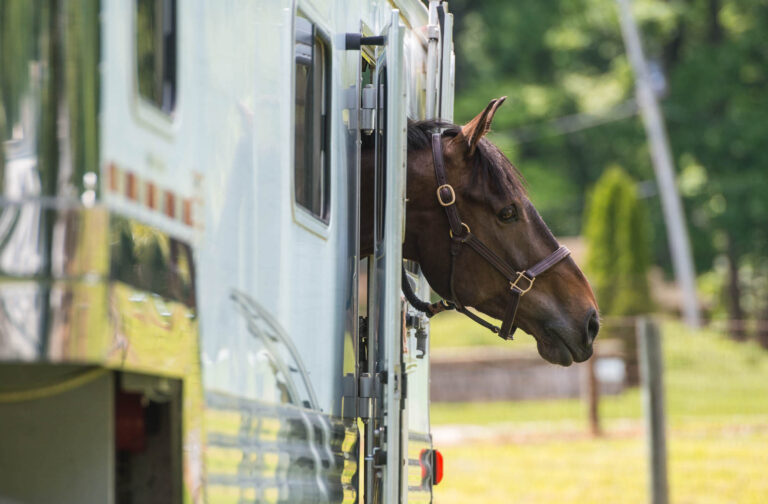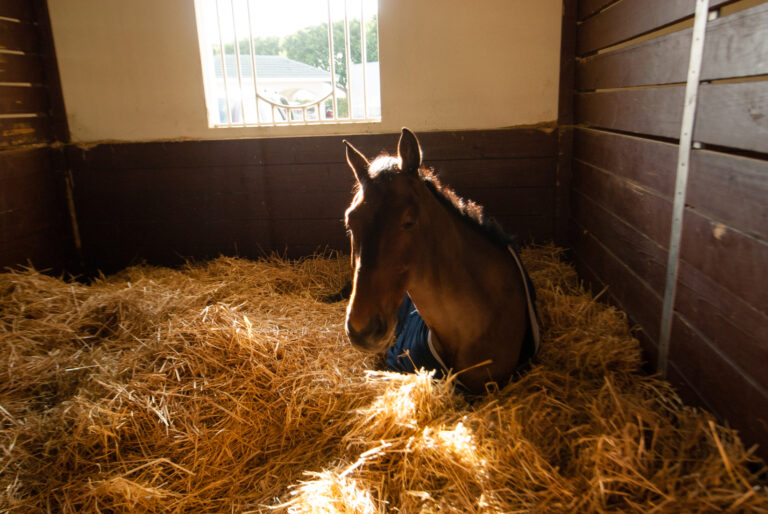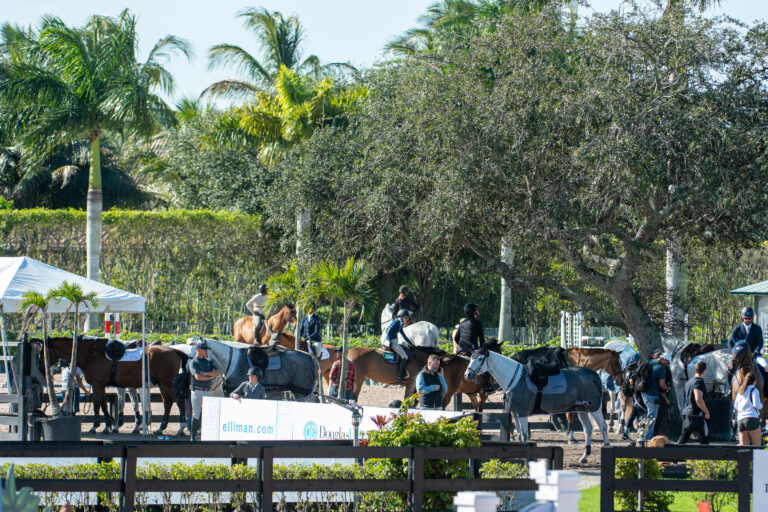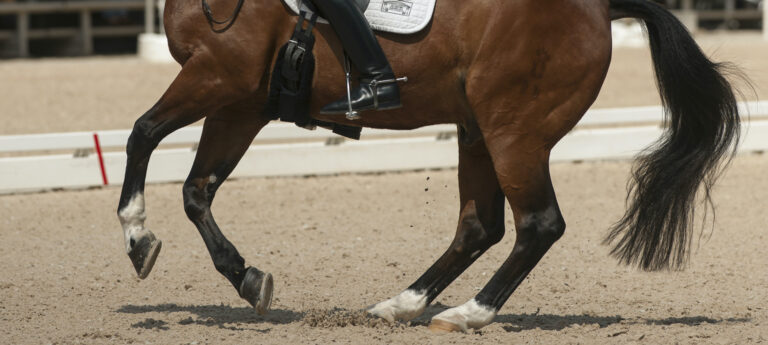Dressage Today’s managing editor Lindsay Paulsen traveled to Germany in the fall of 2016, when she had the opportunity to immerse herself in the country’s equestrian culture. Throughout her tour of the country, she mingled with the world’s equestrian elite—visiting Warendorf, the Germany Olympic Committee for Equestrian Sports (DOKR), the German National Equestrian Federation (FN) and the training bases of several Grand Prix dressage riders: Helen Langehanenberg, Ingrid Klimke and Hubertus Schmidt. In the following article, she shares her experiences meeting these three top dressage riders. (To read more about Lindsay’s trip to Germany, click here.)
Born in 1982, Helen Langehanenberg first attended a riding school at the age of 6. She is a former champion pony rider and student of Ingrid Klimke and has trained extensively with Klaus Balkenhol. She has represented Germany in numerous European Championships and World Championships. In 2012, she competed Damon Hill NRW on the silver-medal-winning Olympic dressage team in London and placed fourth individually. She currently runs her own business and training facility near Münster, Germany, and is competing several horses, including Damsey FRH and Suppenkasper at the international Grand Prix level.
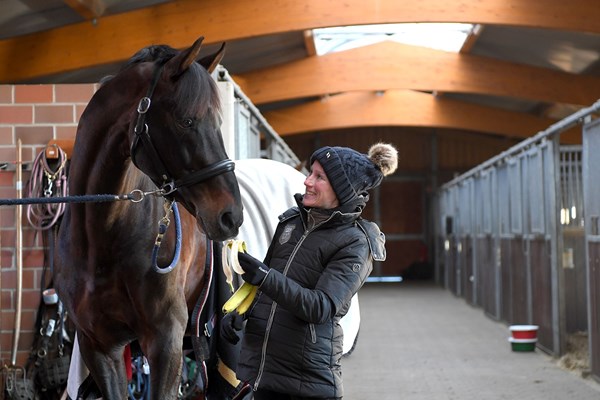
Pulling into the driveway at Helen Langehanenberg’s farm in Billerbeck, Germany, you know immediately that you’ve arrived at a serious dressage training facility. Drive through the gate and you’ll roll down the driveway past perfectly manicured strips of grass and two modern brick barns with minimalist design. Behind the barns, there’s parking and an outdoor dressage ring with windmills rising up in the background behind it. There is a paddock with a large Mercedes horse van parked nearby. Everything is immaculate.

Helen’s office manager, Inge, led me into a cozy seating area in the back of the barn. Within a few moments, Helen appeared and invited me to sit down at the table, offering me a cup of coffee. The very petite Helen is direct yet kind, humble and extremely professional. She is obviously no stranger to interviews. With a tight time schedule, we dove right into discussion about the daily happenings at her farm.
Helen typically begins riding at 8 a.m., working with about 10 horses per day and finishing around 2 p.m. She then gives lessons to her students who own horses at her facility and even a few who trailer in for lessons. Most of her students are already highly educated themselves, and compete at M-level and Grand Prix, but she also works with a few young lower-level riders. Helen is currently working with several horses. One is her Grand Prix mount, the 15-year-old Hanoverian stallion, Damsey FRH, owned by BG Leatherdale Farms. She also has two young horses who are looking like excellent prospects for the young horse Grand Prix this year.
In terms of horse management, her horses receive hay twice a day and are fed three times per day. She turns them out whenever possible (as long as the footing isn’t frozen) and likes to utilize sand paddocks with all-weather footing.
In her training, Helen focuses on good basics and suppleness in the horse’s body. “Without that, your communication will be limited and you won’t be able to accomplish anything in the long term,” she said. “Maybe some can in the short term, but I think you have to have it for good results and for the communication with your horse.” When working on the basics, she advises riders not to do things too early or quickly in their training. Helen mentioned a well-trained and talented young horse she has in her stable, the 9-year-old KWPN Suppenkasper. She said that when he first came to her stable about a year ago, even though he knew the movements well, she wanted to take time to get to know him better before she competed him. “You always have to know each other,” she said. “Now he’s doing almost everything out of the Grand Prix and I think it was a good decision to take that time. Because if you have the basics, you can then improve faster.” Helen also added that Suppenkasper has now won at the Intermediaire Levels with up to a 75 percent. (Click here to read Helen’s training feature on how to develop your horse’s swinging back.)

When I asked her to describe her ideal horse, she said she loves horses who are sensitive and have a real desire to work. To her, Suppenkasper is an excellent example of this. “They must be sensitive. They must want to work and they must somehow fight to give their very best. They must have good gaits and they have to handle their body in the right way so that every movement in the end gets quite easy for them.”
For rider skills, she emphasized the importance of feel. “You can learn the technique,” she said, “but it is difficult to learn the feeling. For sure, that can improve. But if you look at different riders, you can see quite easily who has a sense of feeling and who does not. And if you have to learn that, that will take some time.”
Helen has spent a significant amount of time training with German master Klaus Balkenhol and credits him with teaching her much of what she knows today. “He has a good way of training,” she said. “He’s always quiet and he knows when you can ask for everything and when you can go to the limit and when you have to wait. And that was good to learn. You have to wait until the horse is ready to give it. That does not mean that you cannot ask in between for several things. But it’s ready when it’s ready.”
Hubertus Schmidt, born in 1959, took his very first riding lessons when he was 9 years old with his father, Hubert Schmidt, and a local instructor. Later, his family built their own facility and riding school, Fleyenhof, located near Paderborn, Germany, which allowed for Hubertus to study riding more intensively. Throughout his education, Hubertus also rode at Warendorf and with masters such as Harry Boldt, Reiner Klimke, Johann Hinnemann and Klaus Balkenhol. Hubertus has earned top placings in several European Championships, ridden in multiple World Cup™ Finals and won the German Professional Championship four years in a row. In 2004, he was selected by the German Olympic Committee (DOKR) to compete Wansuela Suerte on the Olympic team in Athens, where he earned the team-gold medal and an individual fifth place. In 2016, Hubertus and the Trakehner stallion Imperio were selected as the traveling reserve pair for the Rio de Janeiro Olympics. Throughout his career, Hubertus has brought more than 70 horses to the international Grand Prix level and coached several elite riders. He and his wife, Doris, and their two children still live on the premises at Fleyenhof.

Fleyenhof is located at the end of a country lane. Passing a cow farm had me wondering if I was in the right place, but as we headed up a hill farther down the road, we very clearly arrived at a dressage training facility. The farm, which has been there since the 1970s, is cozy and comfortable. It’s the kind of place where you wouldn’t mind taking off your shoes and staying for a while. Even though I was a complete stranger, both Hubertus and Doris Schmidt welcomed me almost as if I was an old friend.
When I arrived, I followed Doris through the front door of a building and after walking inside, I looked around to realize that I was in an Olympian’s home. Hubertus came up the basement stairs, pulled on his dress boots and led me out across a grassy courtyard toward the barn, just a few steps from the house.
The main barn is a white brick building with stabling and an indoor arena attached. There’s an old viewing area that overlooks the ring, which received more use when the farm was primarily a riding school. There was plenty of activity in the barn, but despite all of the people coming and going, it didn’t feel chaotic. There were a couple of girls schooling some impressive-looking horses in the indoor ring, while a few other horses stood in the cross ties, being groomed. Hubertus led me into his tack room, which contained more bridles than an average U.S. tack shop even carries in stock. As to be expected, there was also a large collection of dressage saddles, all labeled with metal plates on the back that said “Schmidt” and then their assigned number.
I followed Hubertus downhill along the driveway, past some large hay fields and equipment storage, an outdoor dressage ring and some smaller paddocks. We entered a smaller second barn, where Hubertus introduced me to Imperio, the Trakehner stallion who was his partner for Rio last summer, where he attended as the traveling reserve for the German team. Imperio was happily munching on his hay and at first didn’t bother to look up when we entered. But when he realized he had visitors, he raised is head and was happy to pose for a few photos.
After our visit with Imperio, we headed back up to the house so we could talk more in depth about the daily activities at the farm. I sat down at their kitchen table and noticed a hearth glowing warmly with a fire. Within no time, Doris had placed a plate of cookies and a cup of coffee in front of me.
Hubertus began by telling me that each day at the barn starts around 7 a.m. and continues to about noon, when there is a two-hour lunch break. Work resumes again at 2 p.m. and ends at 5:30 p.m. On Saturdays, work starts at 7 a.m. and goes until 1 p.m. without a lunch break. He typically rides around seven horses a day, which is less than the 10 or 12 per day that he used to ride. He also teaches one to two lessons each day. Hubertus has continued the tradition of keeping family in the operation, as his son and wife, in addition to his eight employees, keep everything in running order. His employees include three bereiters, two learning students and three grooms. His son manages the breeding business at the farm while Doris manages the office.

The basis of the care program is good hay, which they grow and cut themselves. They use large round bales, which Hubertus wants to be dust-free and a little moist. The stalls are bedded in straw, which Hubertus likes to use because he says it is cheaper and more natural for them. The horses get oats, some get muesli and some mash with electrolytes. All of the horses’ blood is checked regularly to make sure that their nutritional needs are being met.
The horses at Fleyenhof typically spend a lot of time moving. According to Hubertus, the top horses work once each day and then come out for a jog later after their work. Others go out in the big field or get hand-walked. In the training, Hubertus says that every horse’s work begins the same way, whether it is a 5-year-old or a Grand Prix horse. They start with a lot of stretching work. The riders do a lot of posting trot in the warm-up, focusing on finding steady contact with a long neck. Hubertus demands correct flexion and bending from the beginning. “All of my horses are good at shoulder-in and half pass,” Hubertus said. “If the horse is good at bending, every movement is easy.”
His ideal dressage horse has quality gaits in the walk, trot and canter. He looks for suppleness and swing in the body as well as good character. For Grand Prix horses, he wants them to be sensitive but sensible. “I don’t want them to be stupid and totally hot, but I want them sensitive to the leg,” he said. When horses are around 4 or 5 years old, he begins to evaluate them for their upper-level potential. He looks at their natural collection and how they move through their body. “Imperio looks perfect. He looks perfect and he is,” Hubertus said. But for him, conformation isn’t a make-or-break factor in determining a Grand Prix horse. His priority is their character and ability to move in their body. “Some horses with bad confirmation can still be Grand Prix horses,” he said.
Hubertus prioritizes good character in his human students as well. He said they are really ambitious in their desire to learn. “They have to be really determined, character-wise. But they can’t be too aggressive. There must be the right balance. They need to be quiet and thinking, knowing when to not ask for too much and be calm, and knowing when to push,” he said. He also mentioned the importance of ambition as it pertained to setting goals. “You need long-term goals and you need realistic goals, where you break down the long-term goals into steps,” he said. “Winning the gold medal? That was not my goal. That was a dream. But to ride Grand Prix—from the beginning, that was my goal.”

I finished up my coffee and thanked both Hubertus and Doris as they showed me to the door. As I walked through the entry hall, I noticed a china cabinet against the wall. A piece of metal glinting in the light caught my eye. “Is that the Olympic medal?” I blurted out loud, drawing toward it. “That? Yes,” Hubertus said. “That’s the one from Athens.” It was gold.
Ingrid Klimke was born in 1968 and credits her father, Dr. Reiner Klimke, with teaching her correct, classical dressage training. In 1998, she began managing her own stable and in 2001, she married her husband Andreas Busacker. Together, they have two children, born in 2002 and 2010. She has competed in five Olympic Games and is a double Olympic eventing champion. She is also a successful international Young Horse and Grand Prix dressage competitor and holds a master’s degree in equestrian management. She focuses her training on working with young horses and bringing them up through the international levels. Throughout her education, she has ridden with figures such as Fritz Ligges, Ian Miller, Anne Kursinski and Christopher Bartle. The late Major Paul Stecken was her adviser and coach. She currently lives near Münster and in addition to her riding and training, is a regular clinician and educational speaker.

The first time I saw Ingrid Klimke ride in person was when I was a freshman in college visiting the World Equestrian Games in Lexington, Kentucky. It was cross-country day. Ingrid galloped by me and as I heard her name ring out on the loud speakers, I was giddy just being in the presence of this international equestrian legend. Little did I know that years later, I would be shaking hands with her on her home turf in Germany. I visited Ingrid’s farm, located just a 15-minute drive from the city center of Münster, on a Training Day. Once a month, Ingrid opens her farm to the public (although you must purchase a ticket in advance, which are limited in number), inviting her fans to get an inside look. When I arrived at the farm, I immediately saw a large cluster of people waiting eagerly outside an old brick barn. Even though everyone was speaking German, I could sense their excitement. The moment Ingrid appeared, I understood why.
Ingrid radiates positive energy. She is animated and warm with a bright smile and friendly nature. But make no mistake—she is a fierce competitor and a serious horsewoman. She has a coolness and calmness that seem to soothe the crowd and the horses around her. You can tell she is at perfect ease when the pressure is on.
We began in the barn and huddled closely together to hear Ingrid introduce a few of the horses. As she shared each of their stories, the horses hung their heads out of their stalls curiously, stretching out their noses in Ingrid’s direction.
Throughout our time at the farm, she emphasized the importance of a training routine that incorporates plenty of variety. Ingrid has both four-star level eventers and Grand Prix level dressage horses in her program, but they are managed the same way. “They do something different every day,” she said of the horses, explaining how it is important for each of them to be developed in all phases. “Doing passage and piaffe every day is not good for the horse,” she said.

As for the care of her horses, each day begins around 7 a.m. for Ingrid’s team. The horses are fed three times daily. Ingrid is also a strong believer in turnout. Her horses get around two to three hours of turnout each day, even in the rain and in the winter. She prefers paddocks to hand-grazing or hand-walking and she even brings portable paddocks to shows whenever possible. She said that as soon as Horseware Hale Bob OLD (“Bobby”), her 2016 Olympic mount, returned home from Rio, he went straight out to his field.
Her training program at home incorporates longeing, jumping, walking in fields and a free day, each once per week, in addition to schooling more specific skills. She also utilizes gallop tracks. Even the dressage horses are trained in jumping. She avoids over training by schooling dressage tests only one to three times before a show. Ingrid has a groom, Carmen Thiemann, and three bereiters on her team. She typically rides 10 to 12 horses each day and the bereiters often warm up the horses while Ingrid does the actual training session, which can last from 15 to 30 minutes.
Next, we headed to the outdoor ring as it started to sprinkle rain. Two of the bereiters were warming up horses to jump. One chestnut stallion in the ring was a young dressage horse having his weekly jump school. The other was a 10-year-old bay mare.
Ingrid explained that the owner of the bay horse initially recommended using a stronger bit, but Ingrid was firm that the horse would go in a bit that was as gentle as possible. She doesn’t like to use bits that offer more control because a stronger bit doesn’t solve the root problem. The bay mare was ambitious and eager to jump. “Breathe in, breathe out, stay calm,” Ingrid coached. It started to rain a little harder and Ingrid summoned the auditors to come help raise the fences in the arena.

After the jump school, we made our way into the indoor viewing area in one of the rings. There was a light lunch for the auditors and during the lunch, Ingrid discussed some of her philanthropic work (profits from the ticket sales were donated to an organization) and answered more questions about her training methods.
Ingrid is a big advocate of buying horses when they are young and turning them into finished athletes herself. “Sometimes you think a horse is not good enough, but then things change. Horses can surprise you,” she said. Ingrid says that finding nice horses can be a challenge because once it is obvious that a horse is going to be nice, he becomes very expensive. She looks for horses with a strong hind leg, good balance, natural impulsion and willingness. Although she says that horses don’t really start coming into their own until about the age of 6, you can determine a horse’s character when he is very young. She also advocates not being in a rush with young horses. “Education takes time,” she said.

Ingrid emphasized the importance of relaxation for both horse and rider. On horses who are sensitive, she said that it is critical for riders to control their emotions. To control your emotions, focus on your breathing. When you breathe out, it forces your body to relax. Horses must learn to control their emotions, too. Ingrid reminded us that once highly sensitive horses are able to control their emotions, they can be terrific partners. “As a rider, you want highly sensitive horses, but that sometimes makes it difficult to find a way to work together,” she said. “You must listen to your horse and think five to six seconds ahead of him, which takes a lot of concentration. You must think faster than your horse.”
For the last session of the day, we watched Ingrid school some squirrely yet stunning young dressage horses and then later, some upper-level horses. She noted that starting your test with a good halt is very important, as it is your entrance card to the judges. She also likes to end her training when her horse is in a good mood, which will help make him more willing to work in the future.
As we watched her school the young dressage horses in the outdoor ring, we heard a gleeful squeal in the distance and hoofbeats. Ingrid chuckled quietly and glanced in the direction of one of the fields, where her daughter and a friend galloped along the fence line on their ponies.
At the end of the day’s activities, Ingrid thanked everyone for visiting. As soon as she dismounted, she was swarmed by fans hoping for photos and autographs. I smiled and resisted the urge to ask for one myself.


